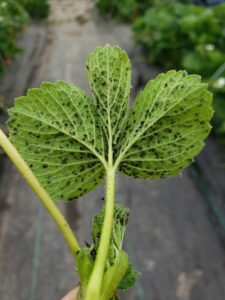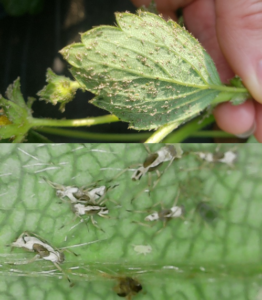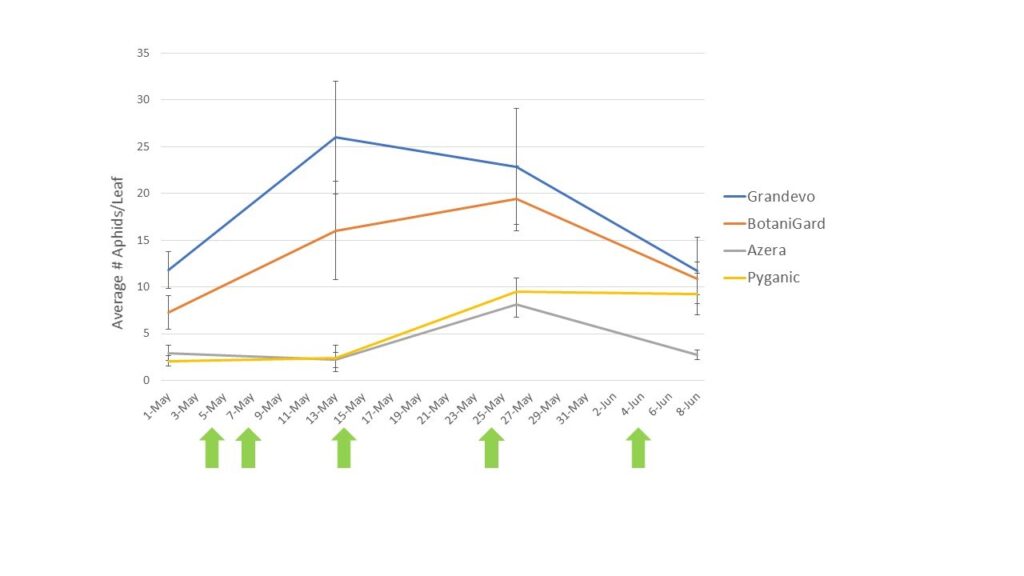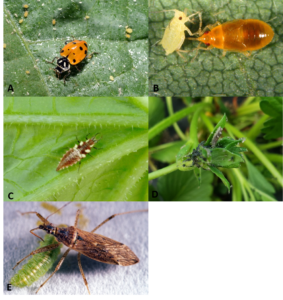Aphids have been a particularly challenging pest to get under control in our high tunnel strawberries this year. They quickly colonized the strawberries we had growing all winter and took off as the weather warmed (Figure 1). In my first attempt to knock them back I introduced 2,000 lacewing larvae (22-Apr), too little too late.

Figure 1. An example of the level of aphid infestations experienced in the high tunnel strawberries prior to treatment applications.
I decided to take the ‘opportunity’ at hand to evaluate four OMRI approved insecticide options. Applications began when populations were much higher than what growers should tolerate, so I would anticipate you would see even better results if you intervene at the first signs of infestation. Table 1 shows the products, active ingredient (A.I.), application rate and dates of applications. The change in aphid populations over the course of this trial are shown in Figure 2. In entomological tradition, I surveyed the aphid population prior to treatment (1-May) to get a baseline. As you can see in the figure, populations were higher in the Grandevo® and BotaniGard® treated rows, prior to the start of applications.
Table 1: Pesticide products and application details.
| Product | Active Ingredient (A.I.) | Application Rate | Application Dates |
| Azera® | Azadirachtin 1.20 %
Pyrethrins 1.40% |
2 fl. Oz. / gal. | 5-May, 8-May, 15-May, 26-May, 5-Jun |
| BotaniGard® | Beauveria bassiana Strain GHA | 3 lbs. / 100 gal. | 5-May, 8-May, 15-May, 26-May, 5-Jun |
| Grandevo® | Chromobacterium subtsugae strain PRAA4-1 | 3 lbs. / 100 gal. | 5-May, 8-May, 15-May, 26-May, 5-Jun |
| Pyganic® | Pyrethrins | 1.4 fl. Oz. / gal. | 5-May, 8-May, 15-May, 26-May, 5-Jun |
Figure 2. Changes in aphid populations across time for the four insecticide treatments. Means are calculated based on number of plants sampled within each treatment on each sampling date + standard errors. Arrows along the x-axis indicate pesticide application timing.
Two of the tested products are biological pathogens, which we can expect to take some time to negatively impact the population. BotaniGard® typically takes 7-10 days to see control, according to the label. The Grandevo® product label recommends a knockdown is applied prior to or in a tank mix application at high populations, which was the case here. The label also suggests application of the high rate with increased volume to ensure coverage and short intervals between applications. In this study we applied the high rate for all products and used an electro-static sprayer to optimize coverage of the product. The results shown here indicate good control being achieved with the Azera® and Pyganic® products, when applied at levels of high population infestations. Over time, Azera® maintains the highest level of control. However, BotaniGard®, Grandevo® and Pyganic® provide the same level of control at the most recent survey (8-Jun). Some unique symptomology observed in the row treated with Grandevo® are shown in Figure 3. There were desiccated aphid bodies that appeared white in color with dark black spots on the back side. This was not observed on aphids in any of the other treated rows.

Figure 3. Aphid carcasses observed on Grandevo®-treated strawberry plants and observed under a microscope.
Observations of Other Pests and Natural Enemies
In addition to monitoring the changes in aphid populations during our insect surveys, we take note of other pests and beneficial insects encountered. In terms of pests in our strawberry plot, we occasionally encounter whiteflies, green planthoppers and some caterpillars but none of these pests have reached economically damaging levels. In terms of natural enemies, we have seen a wide variety including lacewings (eggs and larvae), lady beetles (larvae and adults), syrphid fly larvae, orius nymphs, parasitized aphids and nabid bugs, shown in Figure 4. These natural enemies occur more frequently in the area treated with Grandevo® and to a lesser extent BotaniGard®. This is likely a combination of more prey items available in these treatments and less impact from the pesticide applications. Azadirachtin (neem) and Pyrethrins are toxic to the pests and beneficial insects. Food for thought when designing your pest management program.

